Choosing the right rooster type is one of the essential factors in having a sustainable flock.
Chickens are a great addition to any backyard farm. Not only do they provide fresh eggs, but they also help with pest control and can be used as a natural fertilizer.
While most people think of chickens as being low-maintenance, there is some care that goes into keeping a healthy and sustainable flock.
In this article, we’ll discuss some of the best roosters for a sustainable flock, how to pick the right rooster and introduce him to your hens, and the benefits of having a rooster in your flock.

Benefits Of Having A Rooster In A Flock
If you want a sustainable flock, there’s no way around it; you need a rooster to tend to your hens. More and more hobby farms are moving towards a more sustainable lifestyle, and including a self-sustaining flock is at the top of their list.
The rooster’s job is to mate with the hens to produce fertilized eggs. Without a rooster, your hens will still lay eggs, but they will not be fertilized and, therefore, cannot be hatched.
This means you must have a rooster in your flock if you want to have baby chicks.
In addition to being necessary for reproduction, roosters play an essential role in protecting the flock.
Roosters are naturally protective and will defend their hens from predators and other animals that might try to harm them.
They will also sound the alarm if they sense danger, giving the rest of the flock time to escape or hide.
Another benefit of having a rooster is that they help keep the flock’s peace. Hens can be very aggressive with other chickens, but a rooster usually stops fighting, keeping the peace among the girls.
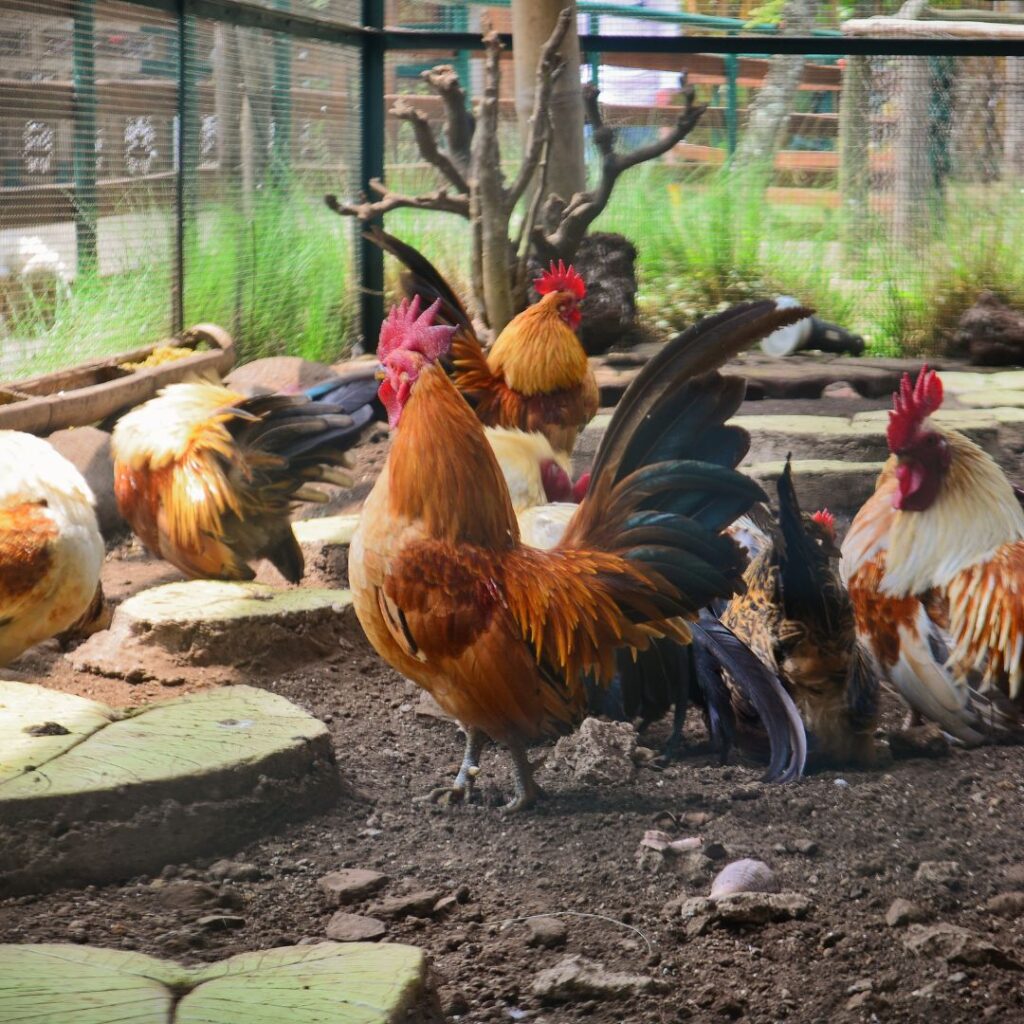
How Many Roosters Are O.K. In A Flock?
How many roosters you have depends on the size of your flock and the amount of space you have available.
Generally, it is best to have one rooster per ten hens so that everyone has enough room and minimal fighting among the birds.
However, if you have a large flock or plenty of space for them to roam, having two or even three roosters might not be a problem. Just keep an eye on them so they don’t start bullying the hens or fighting amongst themselves.
This ratio will allow the rooster to properly care for the hens without being too aggressive. If you have too many males, they may start fighting with each other for dominance which can lead to injury or even death.
If you have too few roosters, they may be unable to properly take care of all the hens, which could result in the other birds being bullied or picked on.
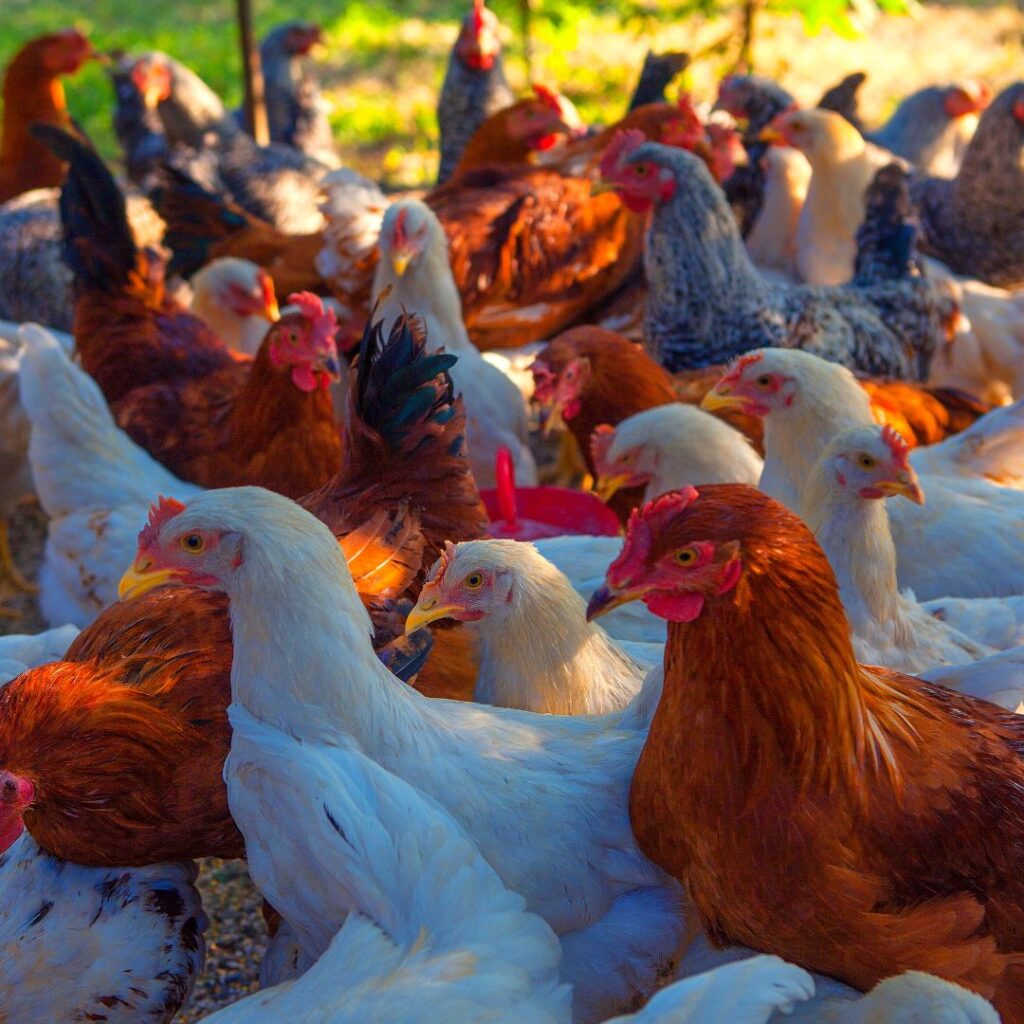
Does Size Matter When Choosing Your Roosters?
When it comes to the size of your rooster, there are a few things to consider. It matters what size your rooster is with the size of your hens when it comes to mating.
Hens and roosters should be roughly the same size to mate more easily. It’s also important not to introduce a giant rooster into a flock of smaller hens, as it will be difficult for them to breed and could injure your birds.
Ultimately, when it comes down to size, it does matter.
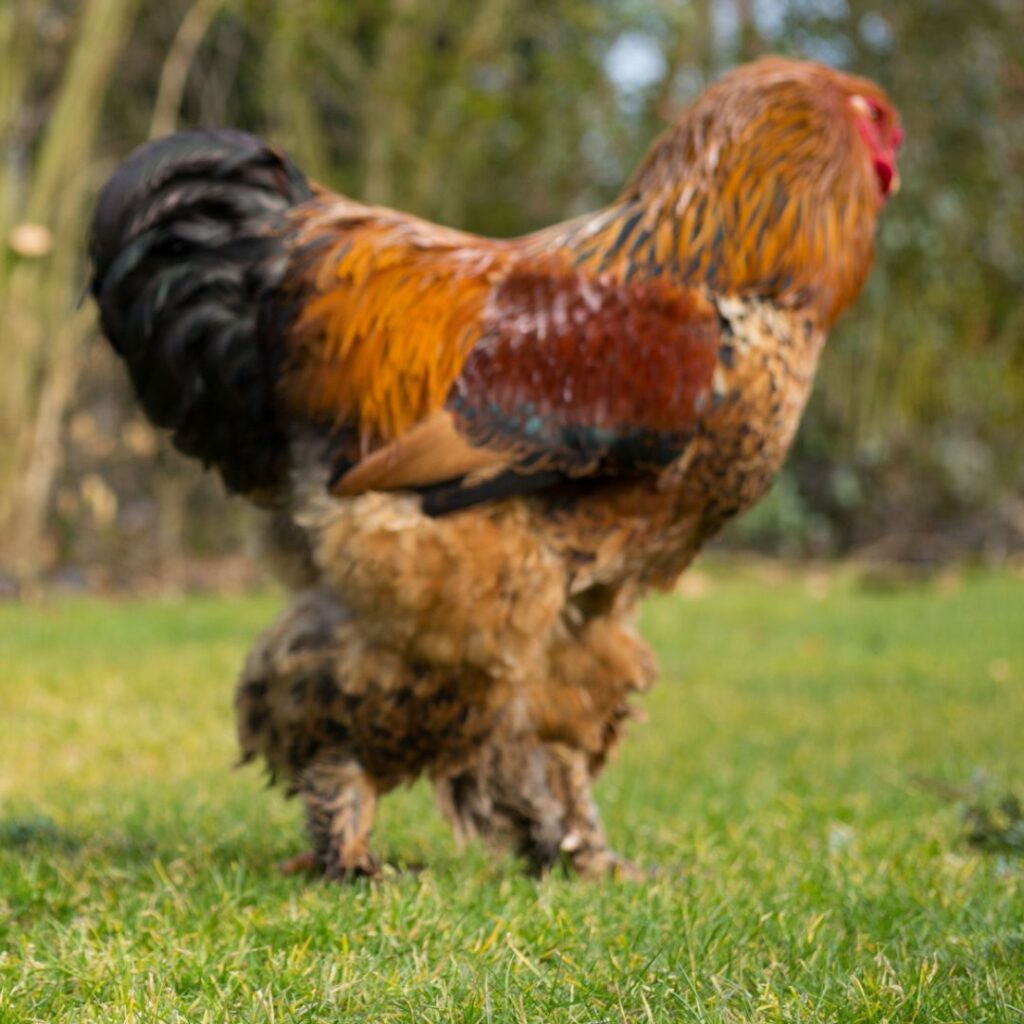
Choosing The Right Rooster Breeds For Your Flock
When choosing a rooster breed for your sustainable flock, there are several factors you need to take into account, including:
- The climate where you live
- The size of your flock
- The type of hens you have
- Your personal preferences
Climate: If you live in an area with extreme temperatures (very hot or frigid), you’ll want to choose a breed known for being heat or cold-tolerant. Some heat-tolerant breeds include the Naked Neck (aka Turken) and Leghorn, while cold-hardy breeds include the Plymouth Rock and Rhode Island Red.
Note: You can find all you need to know about caring for chickens during harsh winter months here.
Size Of Flock: The size of your flock will also play a role in choosing the right breed. If you have a small flock, you can make do with having just one male. However, if you have a larger flock, you’ll need more than one male to avoid fighting among the hens.
Type Of Hens: The type of hen you have will also affect which breed of rooster is best for your flock. If you have smaller hens, such as bantams, you’ll want to choose a smaller breed of chicken, like another bantam, for your male to mate more easily.
On the other hand, if you have larger hens, such as Rhode Island Reds. Orpingtons or Brahmas, you’ll want to choose a larger breed so that they can effectively protect them from predators and mate without causing any harm to the hens.
Then there is also considering if you wish to raise a ‘purebred‘ flock. For example; if you’re hoping to raise a sustainable heritage breed like the Cochin chickens then you’ll want only Cochin males. By the way, Cochin hens are known to be broody too.
Read more about Broody hens here. Read more about Heritage Chicken breeds here.
Personal Preferences: Last but not least, choosing a breed that fits your preferences is crucial. Do you want a calm rooster or one that is more high-energy? Do you prefer a particular color or feather pattern? Considering your preferences will help you narrow down your choices and find the perfect breed for your sustainable flock.
Australorp Roosters
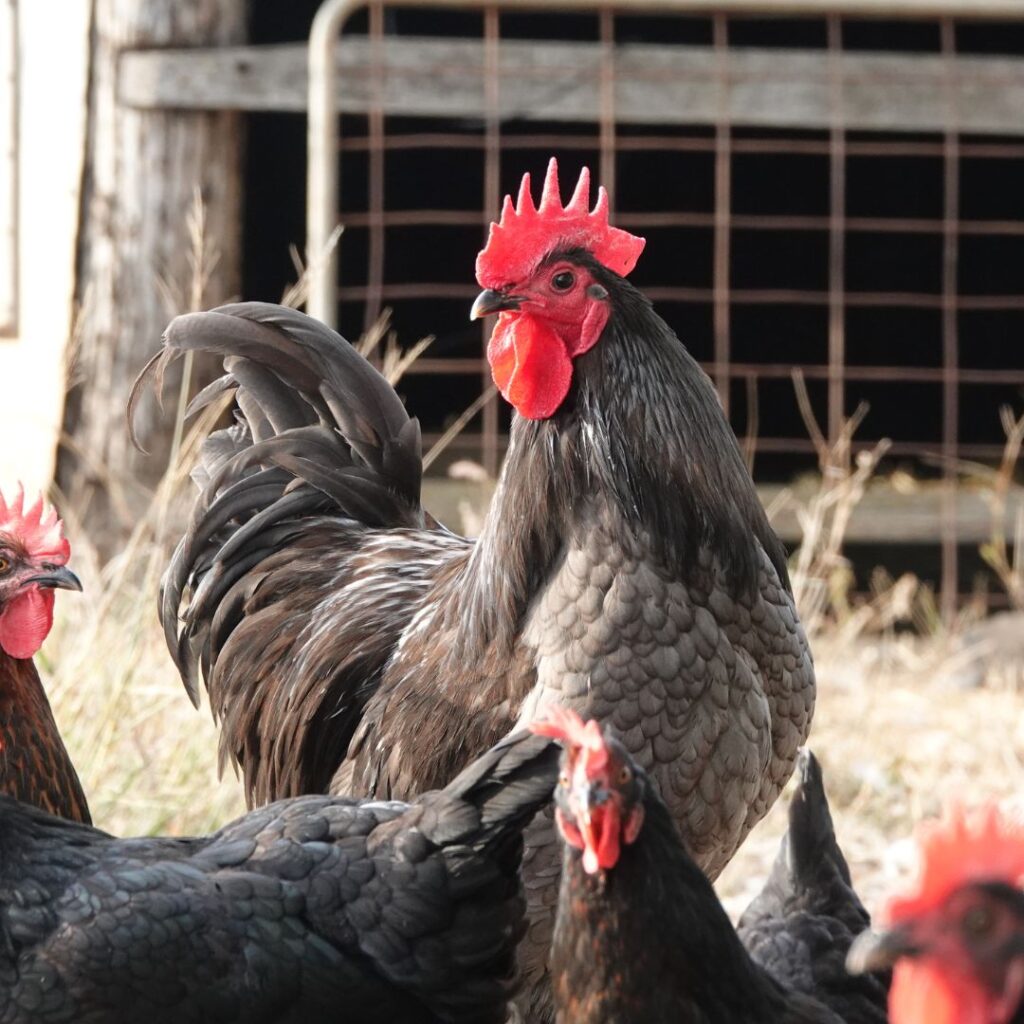
The Australorp rooster is an excellent choice for its watchful nature and intimidating stature. Despite being a lower-energy bird, the size of these birds makes them look somewhat intimidating.
These birds make for great watchful guardians, and their friendly nature often makes them endearing companion animals.
Read more about Australorp chickens here.
- Recognized by APA: 1929
- Cold Hardy – Yes
- Heat Tolerant – Yes
- Free Range – Yes
- Meat Bird – Yes
- Size – Hens 5 1/2 pounds, Roosters 8 pounds
- Australorp Rooster: Hen Ratio – 1 male for every 10 females
Barred Plymouth Rock Roosters
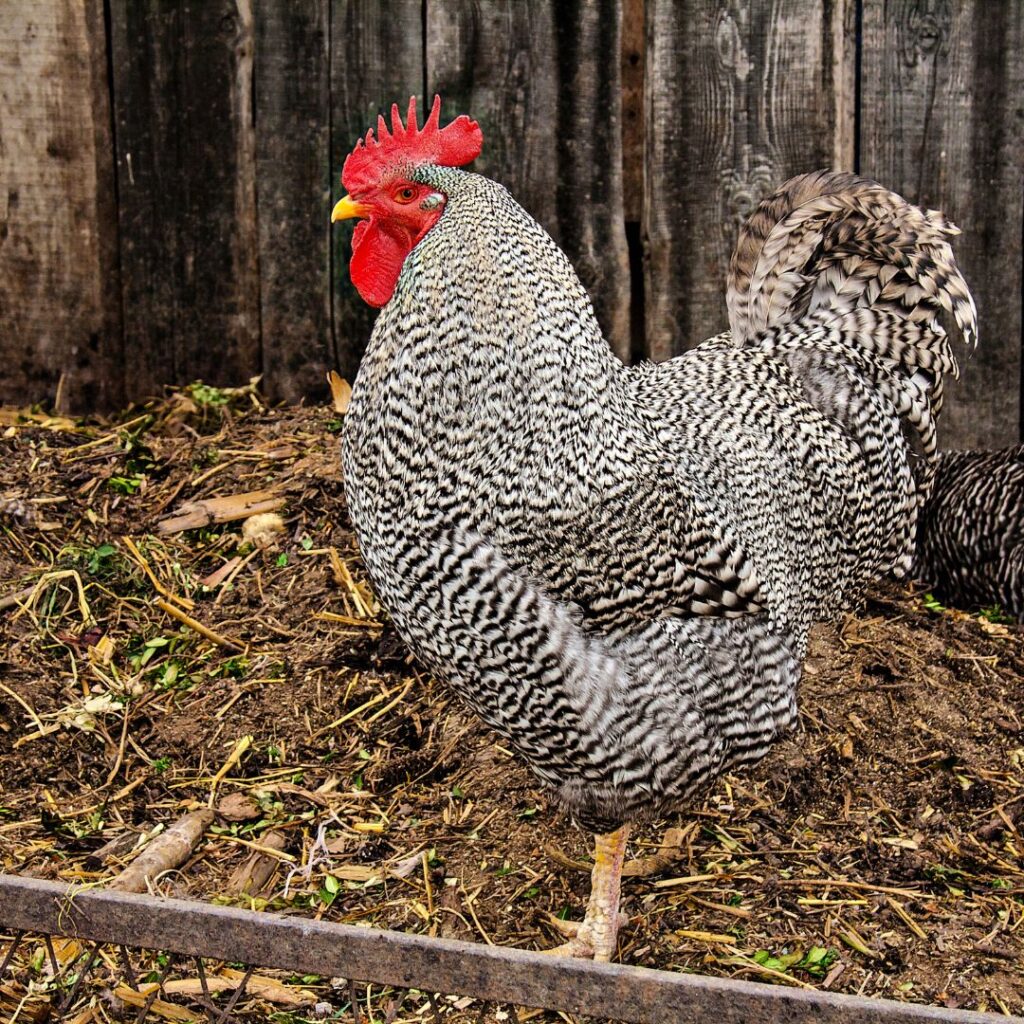
Plymouth Rock roosters, or barred rock roosters, are something sought out by many folks looking for a dependable, friendly rooster in their flock.
They are trustworthy males. Plymouth Rock Roosters are known to be quite intelligent and can recognize the faces of their owners.
Their coloring is a great camouflage which helps in shady areas and tall grass. Read more about Barred Rock/ Plymouth Rock chickens here.
- Recognized by APA: 1874
- Cold Hardy – Yes
- Heat Tolerant – Yes
- Free Range – Yes
- Meat Bird – Yes
- Size – Hens 7 1/2 lbs, Roosters 9 1/2 lbs
- Barred Plymouth Rock Rooster: Hen Ratio – 1 male for every 10 females
Brahma Rooster
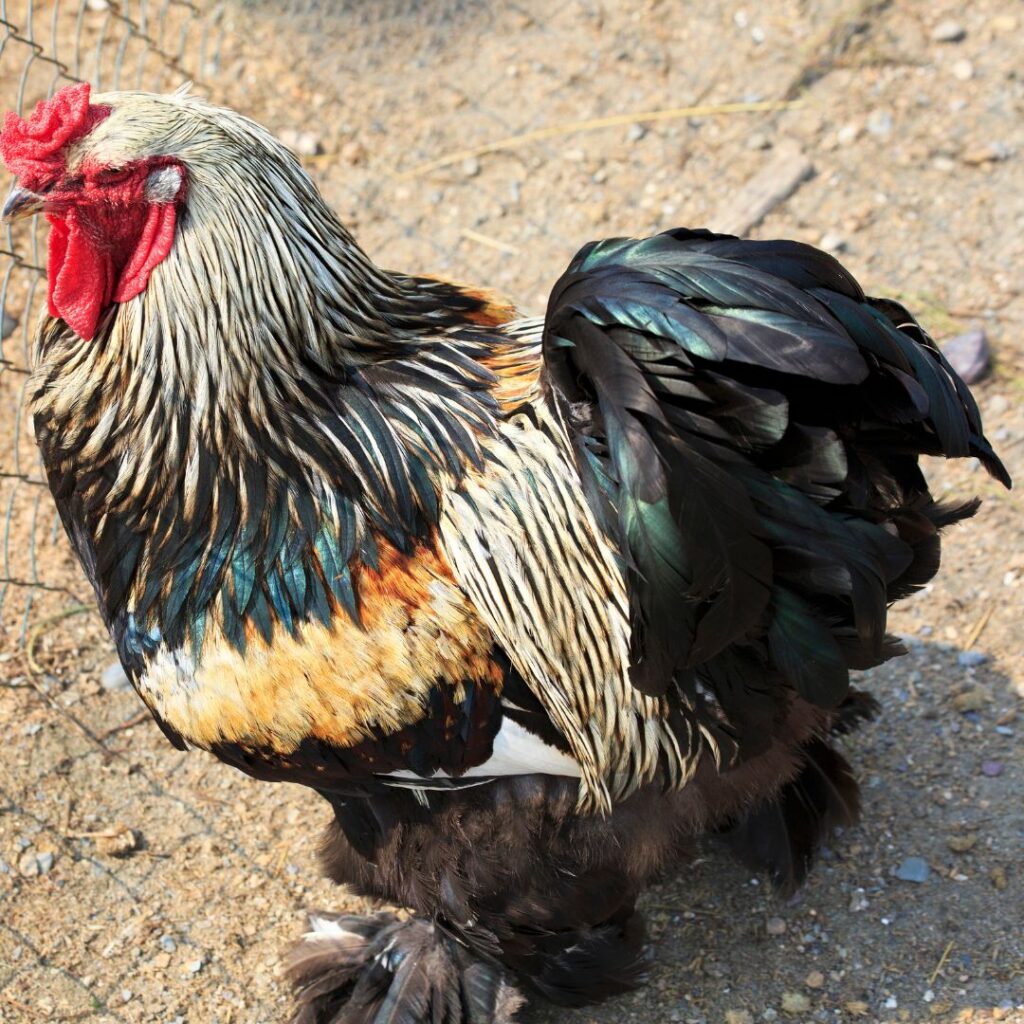
The Brahma is an undeniably beautiful breed. Brahma roosters are nicknamed the King of Chickens and it’s easy to see why, with his large size, second only to Jersey Giants (blacks)
Their size can be intimidating to predators. However, these chickens are calm, docile, and extraordinary human pets. This is definitely a surprisingly docile rooster and is rarely aggressive.
Males are caring and attentive to their ladies. They’ll strut around like the “King” they are but don’t take advantage of their status. They will warn of predators and alert the girls of treats he finds. Although the hens are the primary caretakers of new chicks, even the roosters are wonderful parents, helping to watch over their offspring. Read more about Brahma chickens here.
- Recognized by APA: 1874
- Cold Hardy – Yes
- Heat Tolerant – Yes
- Free Range – Yes
- Meat Bird – Yes
- Size – Hens 9 1/2 lbs, Roosters 12 lbs
- Brahma Rooster: Hen Ratio – 1 male for every 6 females
Cochin Roosters

The Cochin rooster is another gentle giant with a docile and friendly personality, making it an ideal coop mate.
Although a Cochin rooster makes a better pet than a guardian for flocks, this breed may not be the best choice for those who want a bit more assertiveness.
However, Cochins have a 50% fertility rate, and the Cochin hens are known to be broody. This is a great sustainable choice.
The males do their job as co-parents by sitting on eggs during the nesting period when the mamma hen needs a break.
All these traits make these gentle giants an excellent choice for a sustainable chicken breed. Read more about Cochin chickens here.
- Recognized by APA: 1874
- Cold Hardy – Yes
- Heat Tolerant – No
- Free Range – Yes
- Meat Bird – O.K.
- Size – Hens 8 1/2 lbs, Roosters, 11 lbs
- Cochin Rooster: Hen Ratio – 1 male for every 6 females
Delaware Rooster
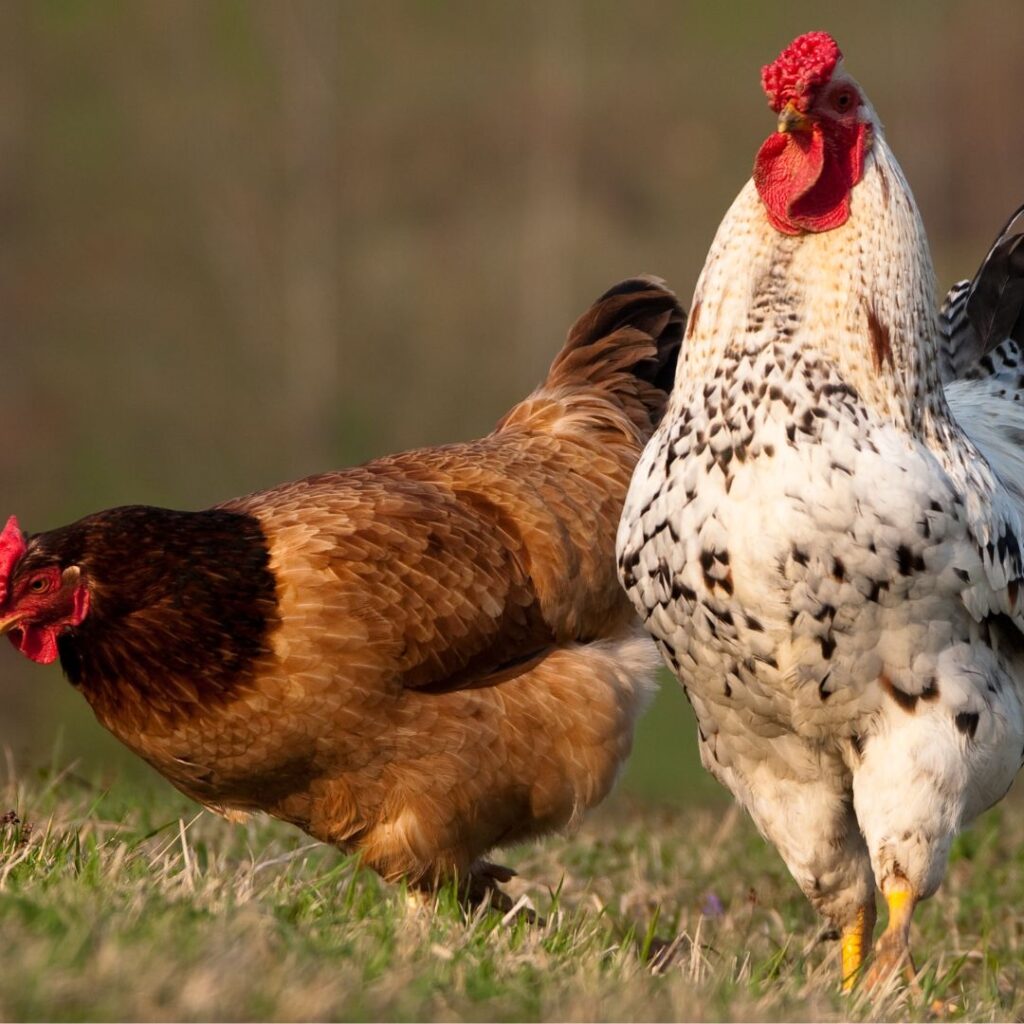
Delaware Roosters are known to be quite gentle when it comes to human interaction, but they can become aggressive if startled. They form a close bond with their flock and take responsibility for their safety by alerting them to any threat with loud voices and, if need be, standing and fighting.
Delaware Roosters make amazing watchful companion animals—always keeping an eye out for faithful hens in their care. Read more about Delaware chickens here.
- Recognized by APA: 1952
- Cold Hardy – Yes
- Heat Tolerant – O.K.
- Free Range – Yes
- Meat Bird: Yes
- Size – Hens 6 1/2 lbs, Rooster 8 1/2 lbs
- Delaware Rooster: Hen Ratio – 1 male for every 10 females
Faverolles Rooster

The majestic Faverolles roosters are one of the more impressive-looking birds around. He sports an elegant show of feathers with a splash of mottled color and is quite proud and stately-looking, far different from his female counterparts.
This is not just a pretty boy. He’s a master in his role of protector of the flock. He patrols the coop like a boss, and when danger appears, he raises the alarm to protect his flock from harm.
They’re also known for their natural sweet disposition and curiosity. These birds are vigilant guardians of their feathered family.
- Recognized by APA: 1914
- Cold Hardy – Yes
- Heat Tolerant – O.K.
- Free Range – Yes
- Meat Bird – No
- Size – Hens 6 1/2 lbs, Roosters 8 lb, Pullets 5 1/2 lbs, Cockerels 7 lbs
- Faverolles Rooster: Hen Ratio -1 male for every 8 females
Java Roosters

Java Rooster breeds are gentle, quite docile, and get on well with humans. A java rooster is typically a good provider for their hens, demonstrated by their watchfulness and protective instincts; java rooster breeds will keep their flock close by and will fight to protect them from harm.
- Recognized by APA: 1883
- Cold Hardy – No
- Heat Tolerant – Yes
- Free Range – Yes
- Meat Bird – Yes
- Size – Hens 6 1/2 – 7 1/2 lbs, Roosters 9 1/2 lbs
- Java Roosters: Hen Ratio – 1 male for every 8 females
Jersey Giant Rooster
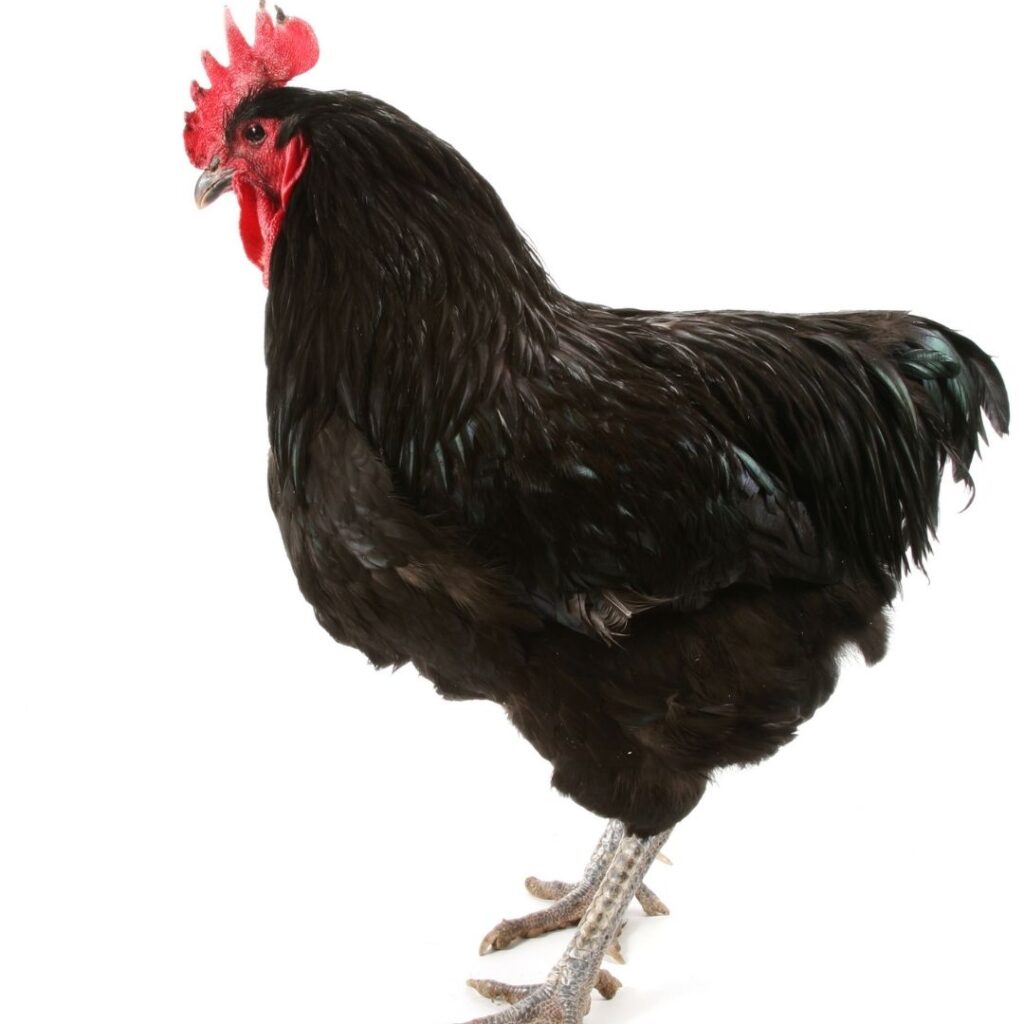
This Giant breed stands over two feet tall, and no doubt will be intimidating to any surrounding predator, giving them a reason to think twice and most likely turn the other way.
This breed is known to be the largest chicken breed in the world today.
Jersey Giants are known to be watchful and helpful flock mates, scouting out treats in a field and alerting the ladies to their find. Read more about Jersey Giant chickens here.
- Recognized by APA: 1922
- Cold Hardy: Yes
- Heat Tolerant: No
- Free Range: Yes
- Meat Bird: Yes
- Size: Hens 11 lbs, Roosters 13 lbs
- Jersey Giant Rooster Flock Ratio: 1 male for every 9 females
Langshan Rooster

Langshan roosters are genuinely one of the more gentle giants in the world of poultry, standing between two and three feet tall and with great composure.
They tend to be incredibly gentle and non-aggressive towards their keeper and flock mates – perfect for those looking for a majestic addition to their backyard hobby farm.
Langshan roosters make great companions due to their quiet demeanor and laid back personalities who handle confinement well. They do best in a smaller free-range setting.
Besides offering serenity and majestic beauty, Langshan roosters are known to act as gentle but fierce protectors for their hens.
- Recognized by APA: 1893
- Cold Hardy: Yes
- Heat Tolerant: Yes
- Free Range: No
- Meat Bird: Yes
- Size: Hens 7 1/2 lbs, Rooosters 9 1/2 lbs
- Langshan Roosters Flock Ratio: 1 male for every 10 females
Orpington Rooster
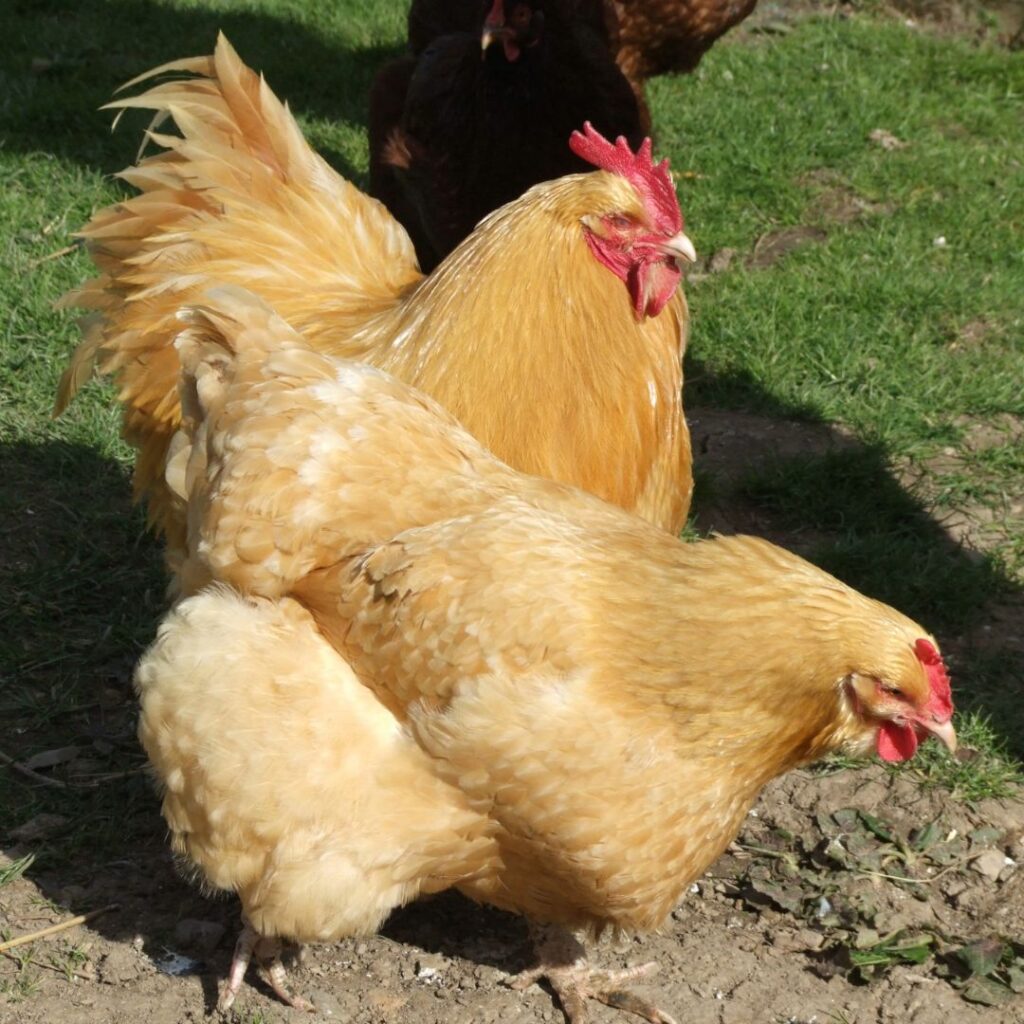
This is one of the favored all-around good rooster chicken breeds. They are Gentle, have a high fertility rate, and are perfect gentlemen with their ladies. They’ll forage for their girls, squawk to keep them from getting in harm’s way, and still be great dads when called upon. Read all about the Orpington chickens here.
- Recognized by APA: 1902
- Cold Hardy: Yes
- Heat Tolerant: Yes
- Free Range: Yes
- Meat Bird: Yes
- Size: Hens 8 lbs, Roosters 10 lbs
- Orpington Roosters Flock Ratio: 1 male for every 9 females
Polish Roosters

The Polish roosters are equally as artistic looking as their hens with those fancy head feathers and color variations they come in.
However, those precious feathers get in the way of their sign and can make it difficult for a Polish rooster to adequately protect his hens. He is willing but can’t spot danger as much as may be needed.
- Recognized by APA: 1874
- Cold Hardy: No
- Heat Tolerant: Yes
- Free Range – No
- Meat Bird – No
- Size: Hens 4 1/2 lbs, Roosters 6 lbs
- Polish Rooster Flock Ratio: 1 male for every 7 females
Rhode Island Red Rooster
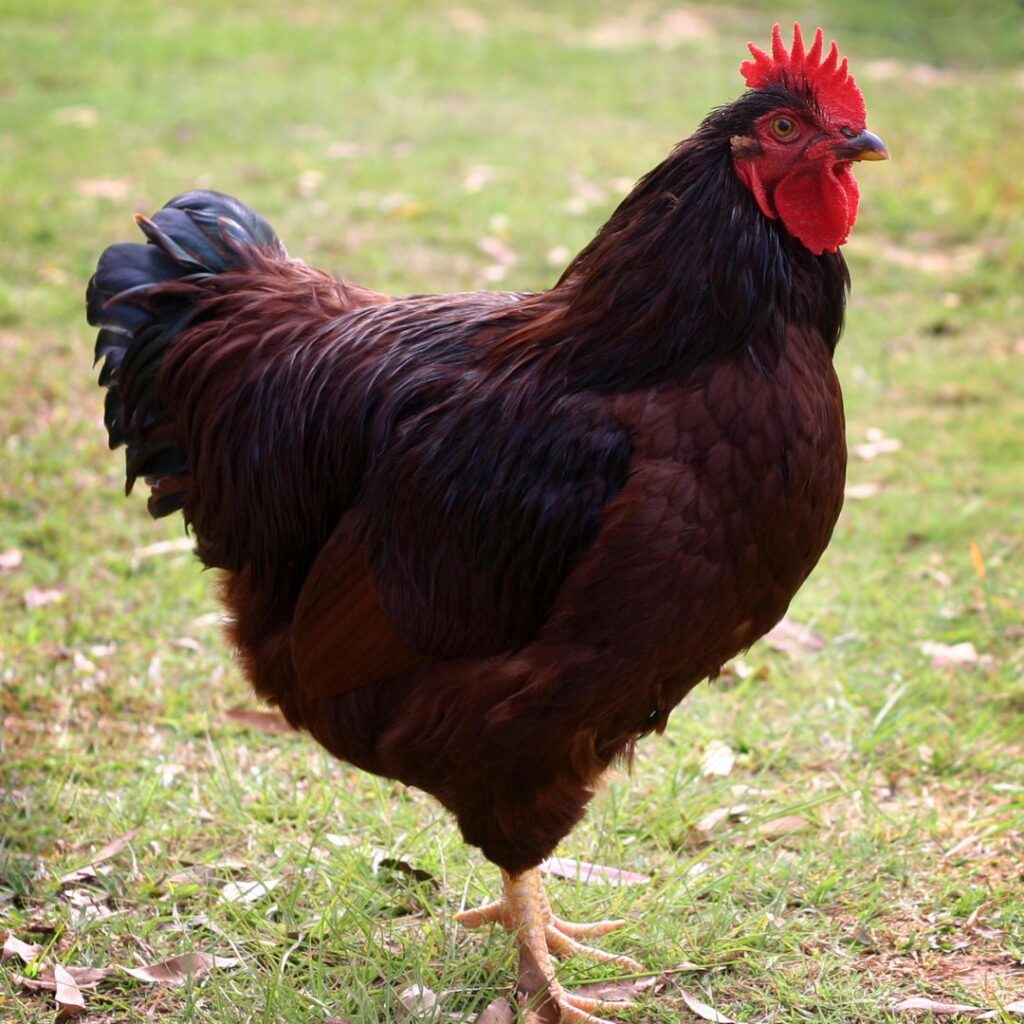
There can’t be a chicken owner around these parts of New England that hasn’t owned at least a few Rhode Island Reds in their time.
These hens have a reputation for prolific egg-laying, but the Rhode Island Red Rooster hardly ever gets the credit he deserves. Not only are they beautifully feathered, but they also have a knack for knowing when and how much protection the hens need.
He is a very motivated ‘breeder’ come the breeding season. There’s no doubt about that! If you have a broody hen or two, a Rhode Island Red Rooster will surely be a great asset to keeping those baby chicks coming every summer. Read more about Rhode Island Red chickens here.
- Recognized by APA: 1904
- Cold Hardy: Yes
- Heat Tolerant: Yes
- Free Range: Yes
- Dual Purpose Chickens: Yes
- Size: Hens 6 1/2 lbs, Roosters 8 1/2 lbs
- Rhode Island Red Rooster Flock Ratio: 1 male for every 10 females
Sussex
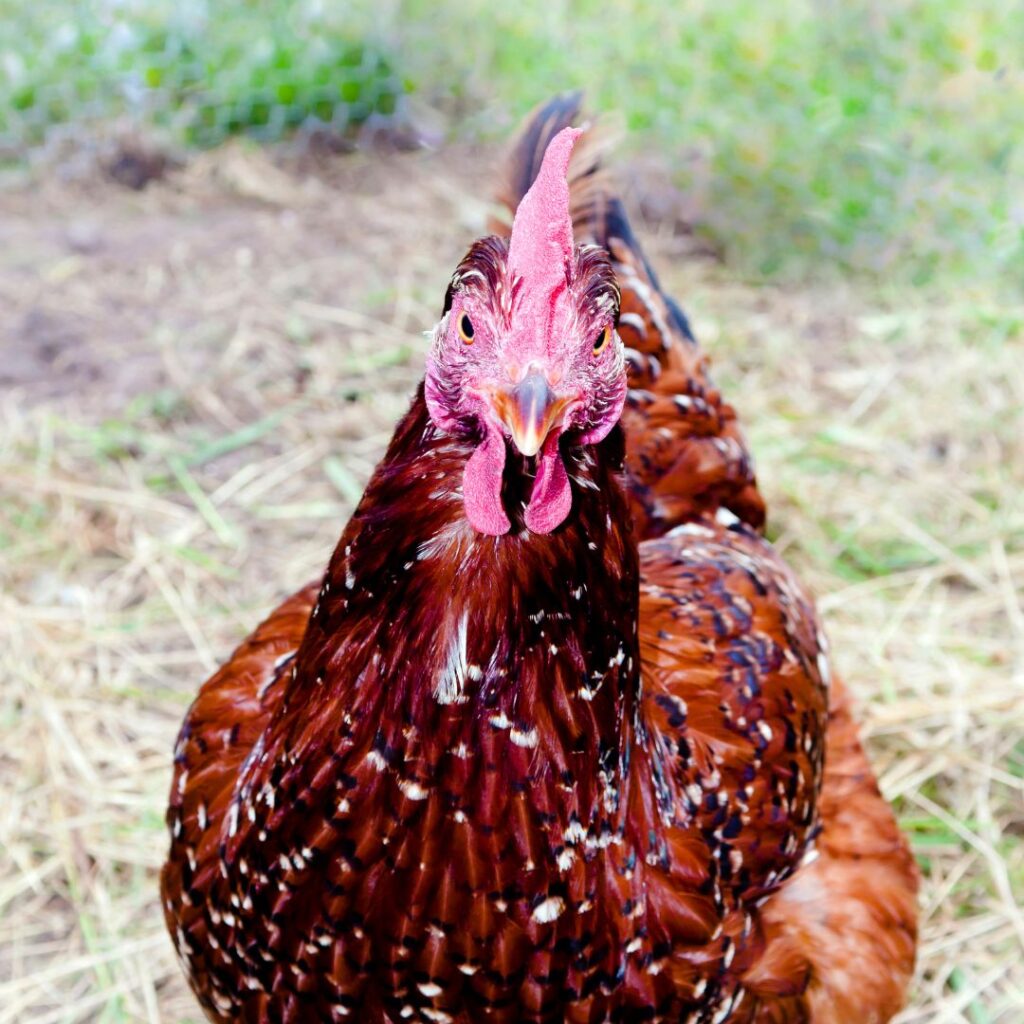
The Sussex is a perfect breed. He will alert his ladies to get to cover if he senses danger. He’ll risk his life to protect these ladies if called upon.
These chickens have a fertility rate higher (up to 75%) than many other breeds, and matched by a hen likely to go broody, you’ll be sure to have an opportunity to preserve the lifeline of a heritage breed. Read more about the Speckled Sussex here.
- Recognized by APA: 1914
- Cold Hardy: Yes
- Heat Tolerant: Yes
- Free Range: Yes
- Meat Bird:
- Size: Hens 7 lbs, Roosters 9 lbs
- Rooster: Hen Ratio: 1 male for every 10 females
Welsummer Rooster
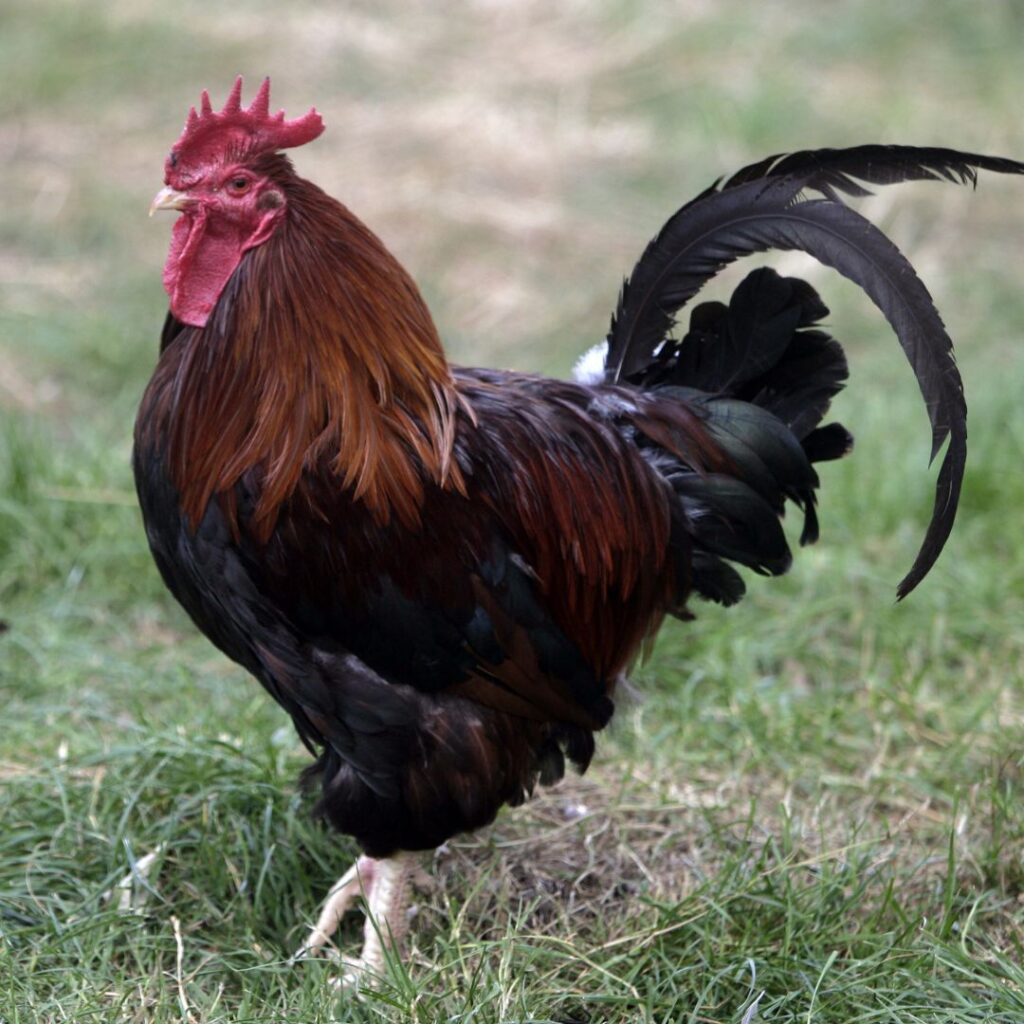
The Welsummer rooster breed is a sight to behold when standing in the sunshine. These handsome birds are known for their flattering plumage and mellow behavior toward people.
As attentive as these Welsummers often are to their human owners, they give priority to their female companions in the flock.
They actively ensure that each hen is adequately fed and remains safe from potential predators. The Welsummer rooster is recognized for being adept at sounding alarms whenever abnormal activity is detected by surrounding predators or even storms on the horizon, keeping all aware of possible threats. Read more about Welsummer chickens here.
- Recognized by APA: 1991
- Cold Hardy: Yes
- Heat Tolerant: Yes
- Free Range: Yes
- Meat Bird: Yes
- Size: Hens 6 lbs, Roosters 7 lbs
- Welsummer Rooster Ratio: 1 male for every 10 females
Bantam Roosters
Check out these miniature roosters below.
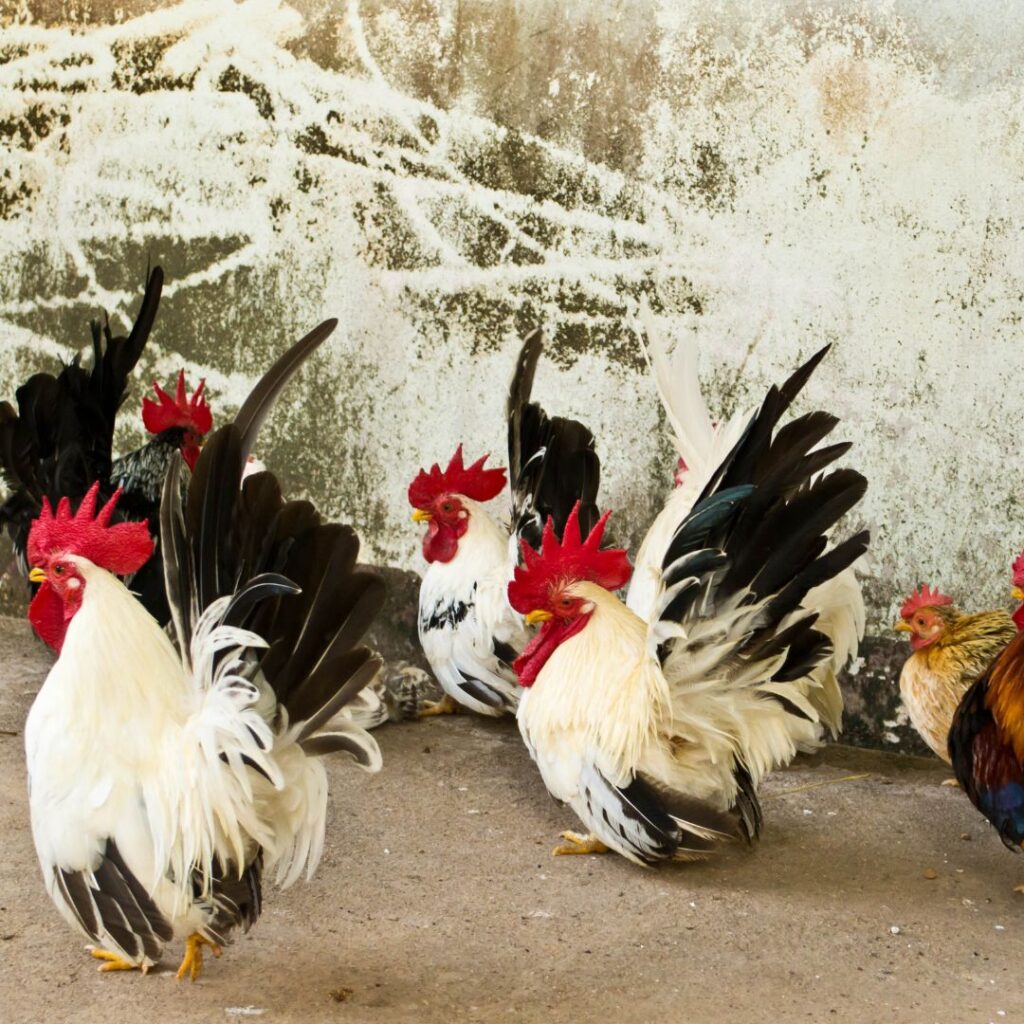
Barbu D’Uccle Roosters
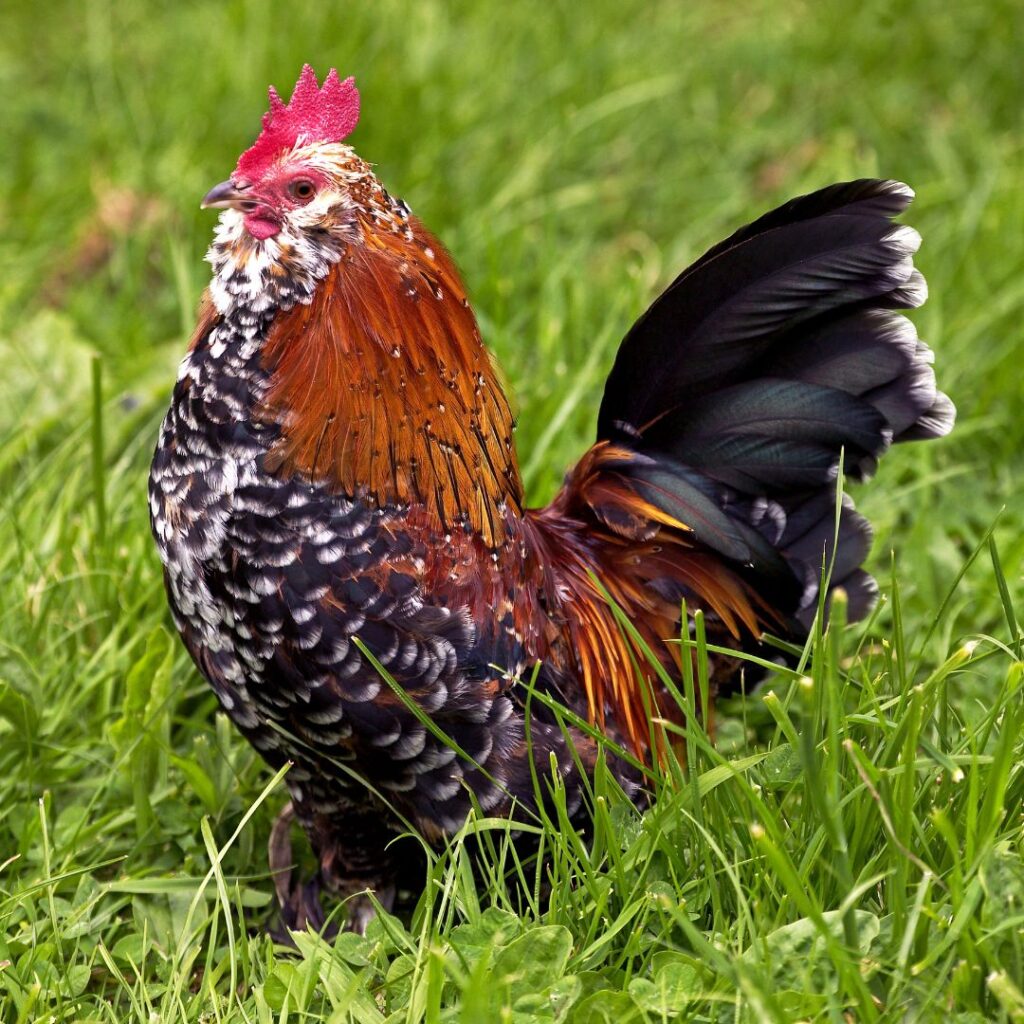
The Barbu D’Uccle bantam rooster is a sight to behold. Despite their small size, they boast prominent personalities. These lucky hens get to enjoy tidbits of food supplied by the old gentleman, and while they’re at it, they get monitored dutifully to ensure they’re safe.
These small yet mighty birds have incredible warning systems that let the females know when danger is near so that they can take appropriate action.
Although its size is diminutive compared to bigger breeds, Barbu D’Uccle roosters is not the bird that will back down from a confrontation regardless of size. Read more about the Belgium (Mille Fleur) Barbu D’Uccle Bantam chickens here.
- Recognized by APA: 1874
- Cold Hardy: Yes
- Heat Tolerant: Yes
- Free Range: Yes
- Meat Bird: No
- Size: Hens 1 1/2 lbs, Roosters 1 3/4 lbs (Belgian D’uccle size
- Barbu D’Uccle Rooster Ratio : 1:6
Sebright Roosters
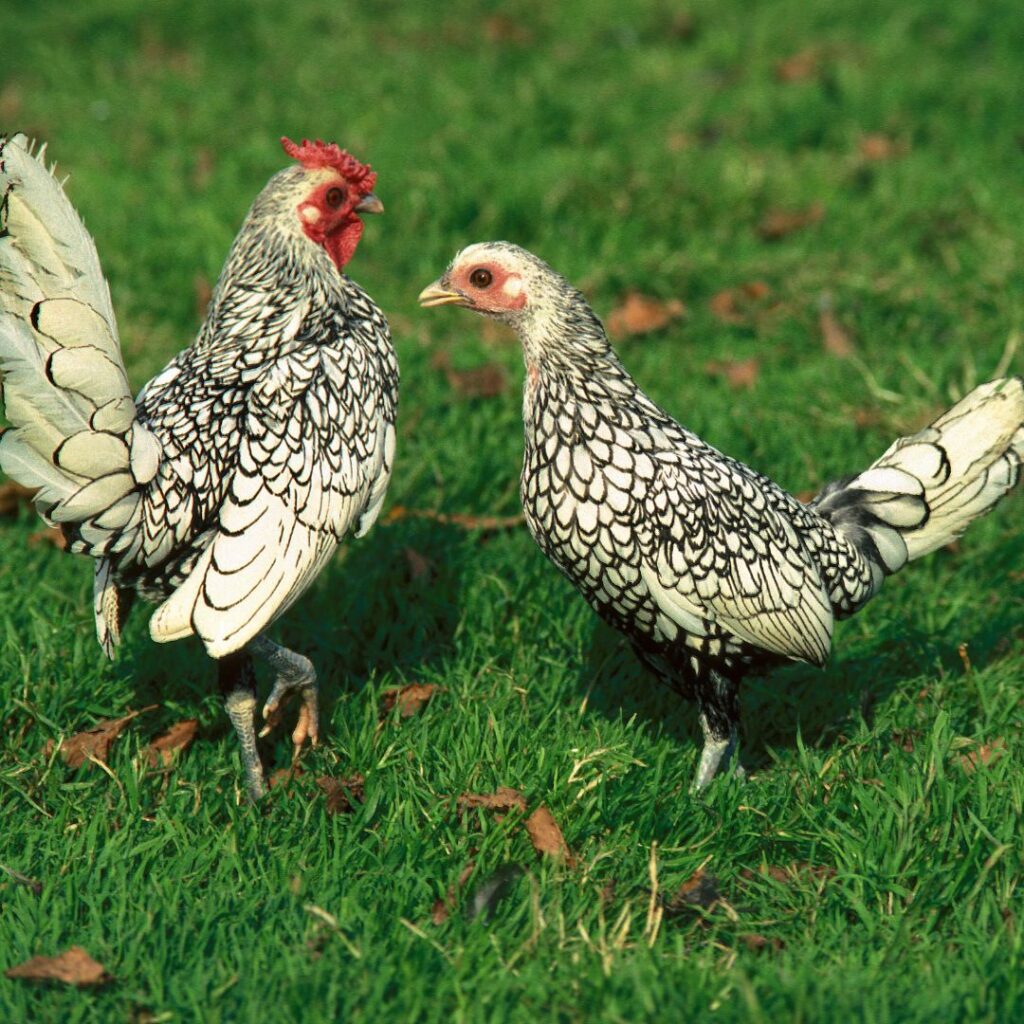
Sebright roosters and their hens are chatty birds, which is uncommon for roosters, who usually only get vocal when something needs to be taken care of.
While the Sebright rooster may have the gift of gab, his personality can be a bit overprotective, so it pays to socialize with your male early on, so you’re not prevented from enjoying the company of your flock. Read more about the Silver and Gold Sebright Bantam chickens here.
- Recognized by APA: 1874
- Cold Hardy: Yes
- Heat Tolerant: Yes
- Free Range: Yes
- Meat Bird: No
- Size: Hens and Roosters 1 1/5 lbs
- Sebright Rooster Ratio: 1:8
Silkie Rooster
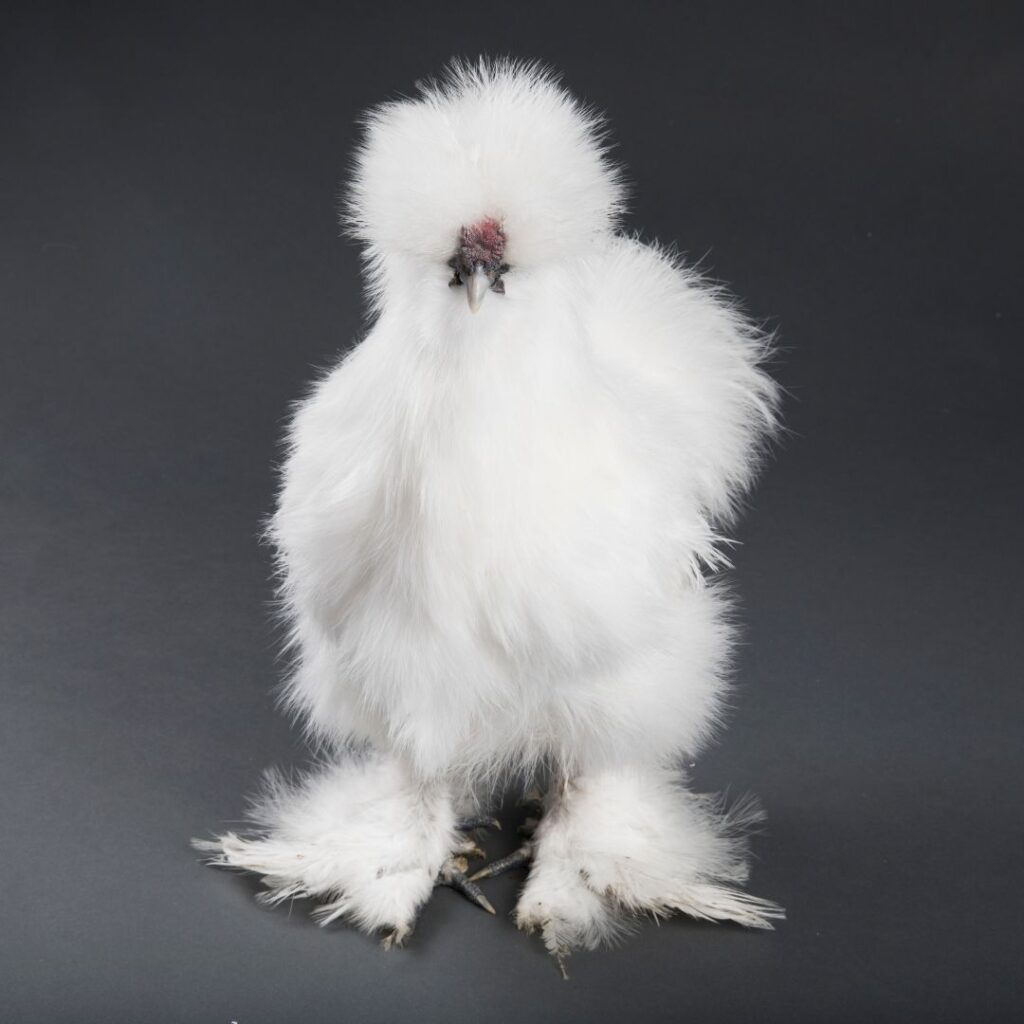
Silkie Roosters are one of the most adorable chickens out there for pets. However, for protection, that is best left to the chicken owner. These birds will undoubtedly alarm the ladies to danger, but they are more of a lover than a fighter when defending their flock.
However, the hens are likely to go broody, and with males having up to a 50% fertility rate, they will certainly help in preserving the family bloodlines.
- Recognized by APA: 1874
- Cold Hardy: Yes
- Heat Tolerant: Yes
- Free Range: No
- Meat Bird: No
- Size: Hens 2 lbs, Roosters 2 1/2 lbs
- Silkie Rooster Flock Ratio – 1:6
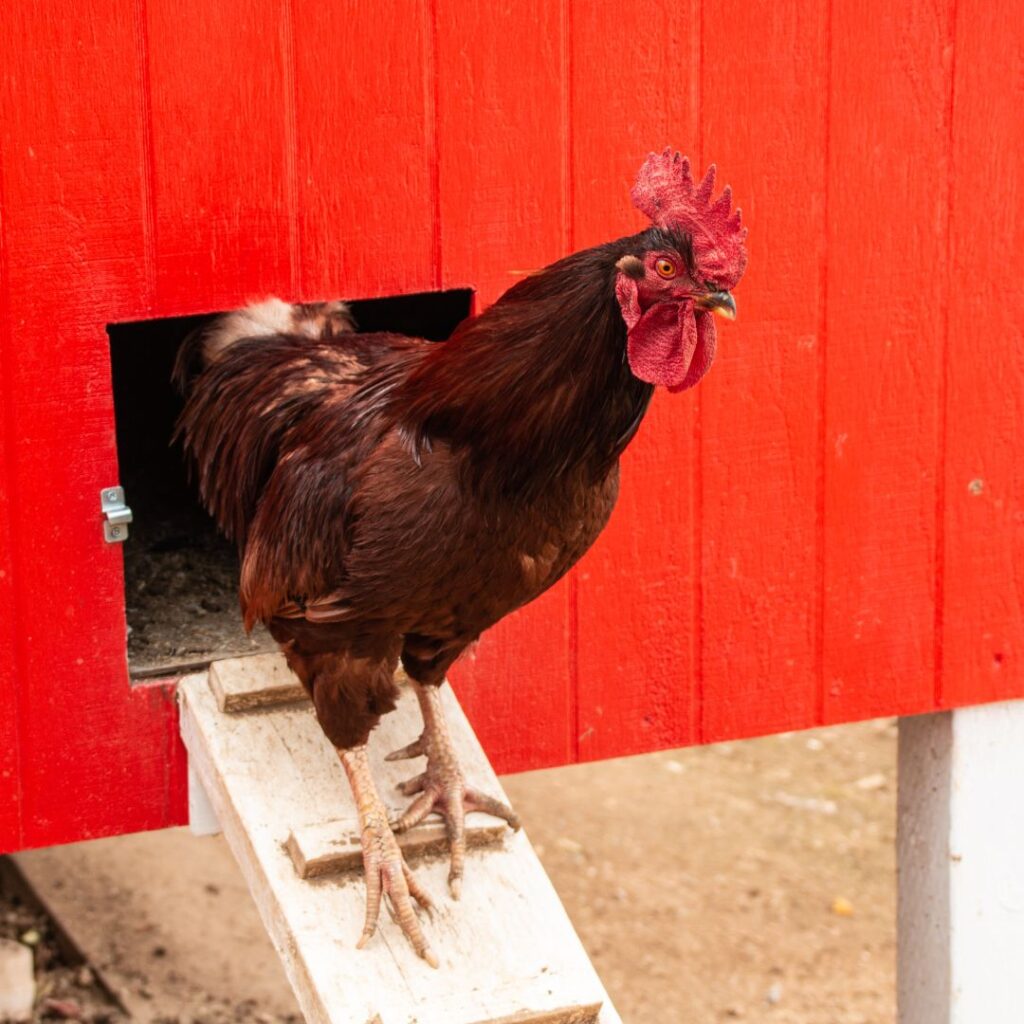
How To Introduce A Rooster To A Flock Of Hens
We’ll preface this by letting you know the younger the rooster, the easier the transition will be.
A chick raised by a mamma hen will have no transition time, as the mamma will do all the introductions and protect him until he is ready to be independent.
A young cockerel is still maturing and will transition easier than a fully developed male (rooster).
Introducing a new rooster to a flock with no other rooster doesn’t have to be complicated. To start, it’s always best practice to isolate the new rooster for 2 weeks, just as you would any other bird.
During this period, he should remain in a nearby pen so that the hens can get comfortable seeing and hearing him ahead of his release.
After the isolation period is up, you can introduce him to the flock. To do so most effectively and stress-free for all involved, place him on his new roost at night when he and the flock are settled and relaxed.
Make sure the outdoor run ,and indoor coop have has plenty of extra treats and some added perch areas to distract everyone from any over-curiosity the following day.
Once integrated into their environment, your new rooster will take ownership of his responsibility by flirting with them, finding them tasty treats, and ensuring they return home before dark. He’ll undoubtedly be protective of his new girls too.
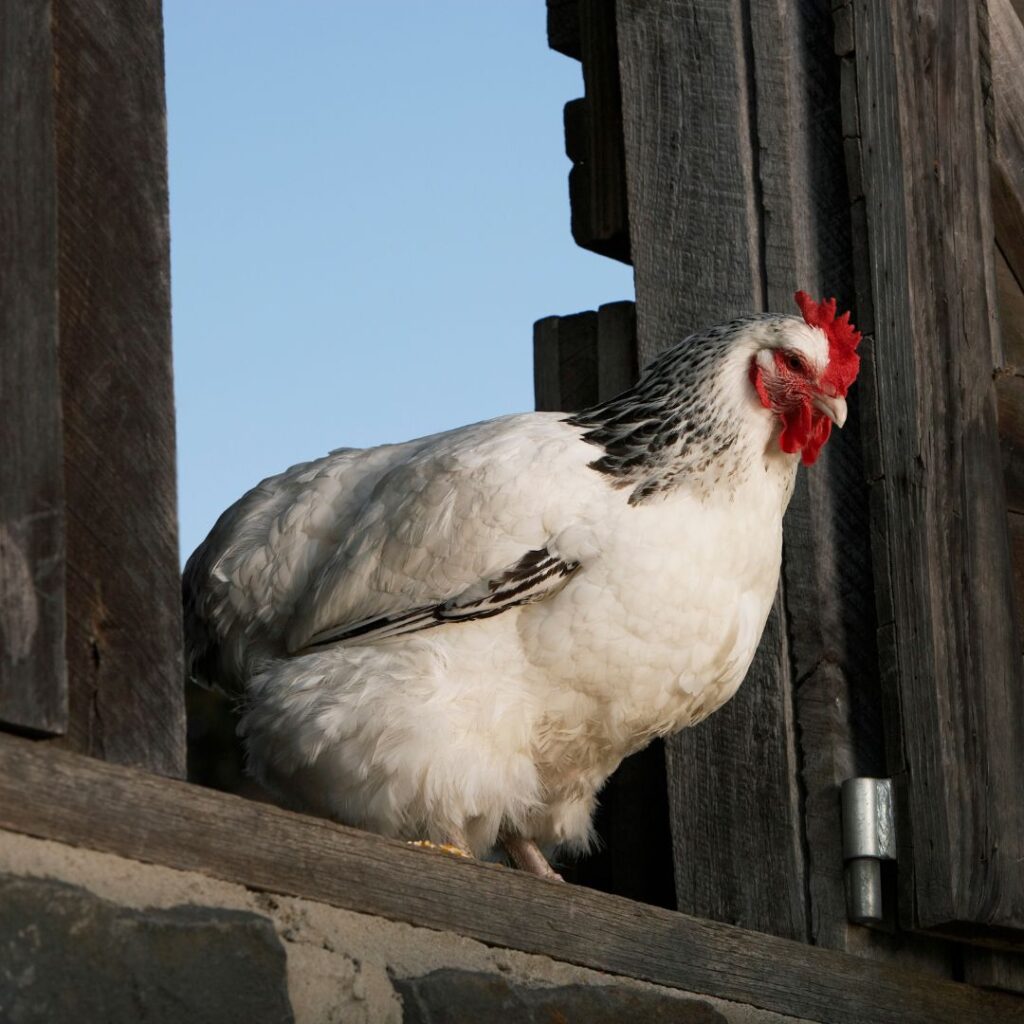
The Mean Girl
If you’re transitioning to an established flock of hens, there is undoubtedly a pecking order in place.
Chicken owners who raise various chicken breeds notice the ‘dominant’ hen being a bit too aggressive with their new male roommate. In this case, remove the ‘mean girl’ offender and place her in a separate pen area (even a large dog crate will do) for a day or two at the most, then set her back in at night on the roosting site.
The following morning all should be O.K. in their world. At most, you may need to repeat this one more time before she gets readjusted to the new kid on the block.
This whole process almost always eliminates aggressive behavior.
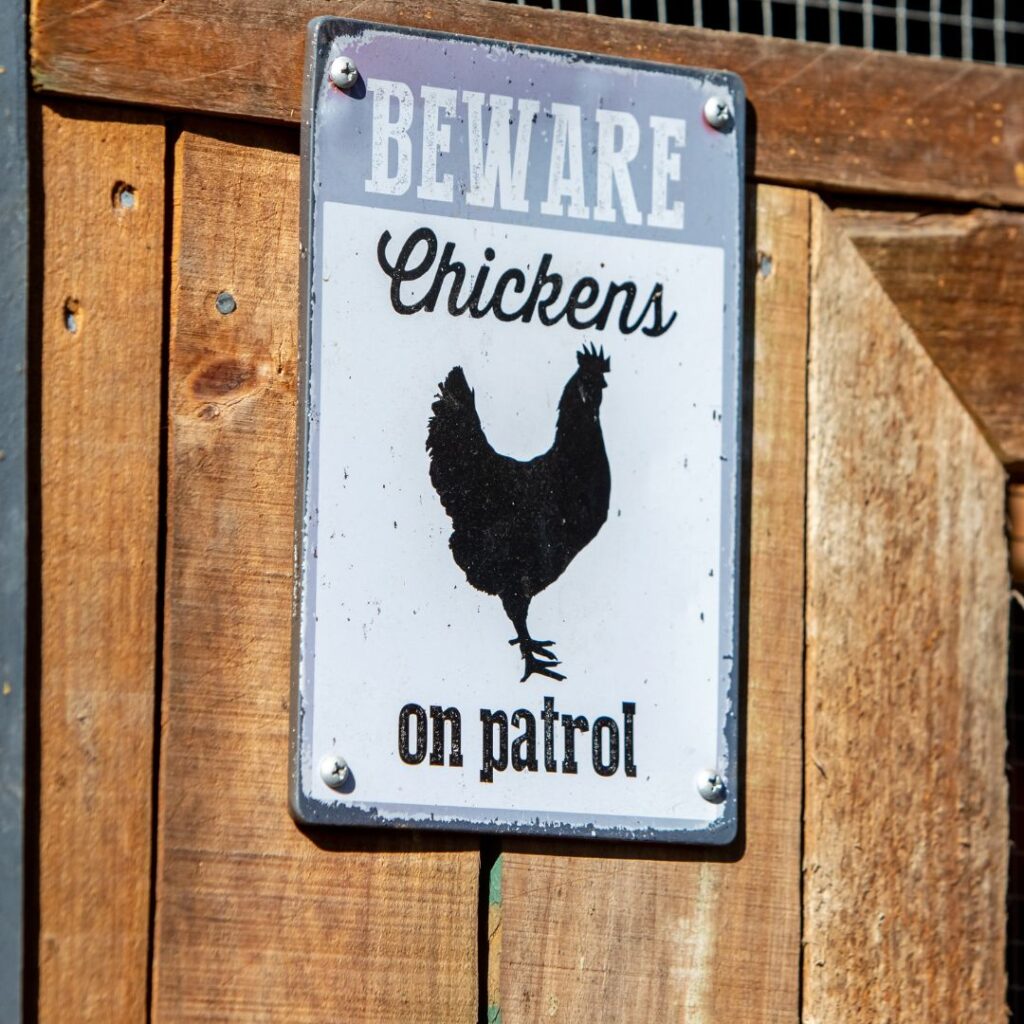
Summary: What Type of Roosters Are Best For Your Sustainable Flock?
There are many factors to consider when choosing the right rooster breeds for your sustainable flock. Raising chickens is easy if done responsibly and planned.
Some of the things you want to consider are climate, size of the flock, type of hen, and personal preference. All these things play a role in finding the perfect match for your farmsteading needs and having happy chickens.
Do some research and ask around at your local feed store or online forums with others in the chicken world before making your final decision. After all, there’s no such thing as too much information when it comes to ensuring the health and happiness of your animals.
FAQ
Is A Rooster An Actual Breed?
Nope, we occasionally use the term loosely in this article. However, a Rooster is the sex of a chicken. A breed is determined by the chicken breed, both males and females. The more proper way to put it is Breed ‘of’ Rooster.
What is the most aggressive rooster?
The Thai Game Fowl is infamous for being the most aggressive rooster.
What are the calmest roosters?
Some of the favorites are the Brahma rooster, Cochin roosters, Barred Rock roosters, Orpington roosters, and Silkie roosters.
Can a rooster breed with any hen?
Yes, they can if the size is appropriate. A large chicken cannot safely breed with a small chicken. It’s awkward and unsafe for the birds.
Mating time can be stressful for your males, so try not to make it any harder by putting them in with hens that are just not sized appropriately for their abilities.
Is There A 3 foot tall rooster?
There are reports of a breed of chicken called “Indio Gigante” These are said to be bred from Maylays. They are from South America.
Can A Rooster Lay Eggs?
Anatomically, roosters canNOT lay eggs. These are the ‘boys’ in the flock. For a list of the 15 best egg laying hens, read more here.
What Is the age roosters start crowing?
Roosters start crowing starts at various ages, depending on the breed. Typically, roosters crow around 16 -24 weeks. Some breeds may start as early as 12 weeks, while still, others may not start until 32 weeks old. If your rooster crows sooner, it could be a cockerel feeling particularly dominant.
What Is The biggest rooster in the world?
It’s a Brahma chicken, one of the largest recorded chickens. The record holder for the biggest individual chicken is named Merakli, from Kosovo. He weighed (the size of a toddler) 23 pounds!



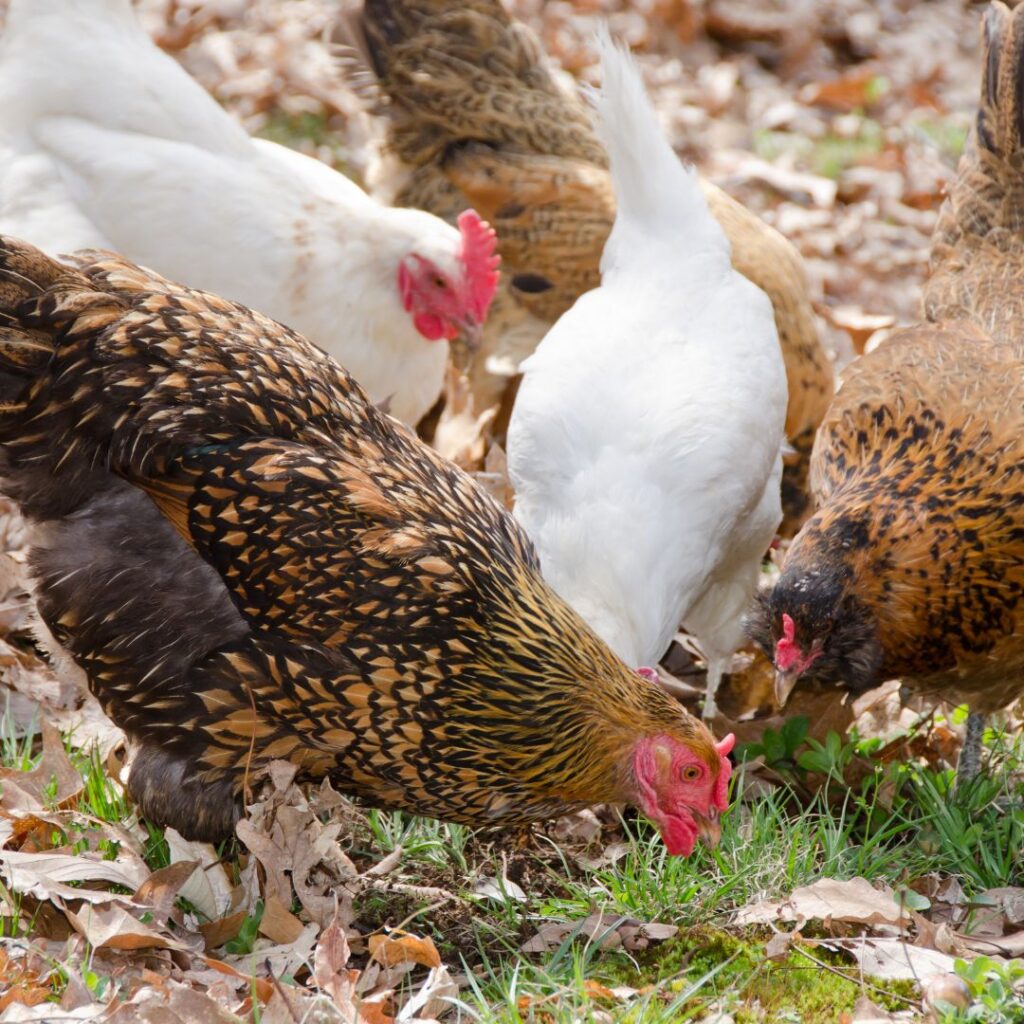

Pingback: Brahma Roosters and Hens: All About
Pingback: Silver and Golden Sebright Chickens; Bantam Breeds - Gilmore's
Pingback: Ameraucana Chickens; About These Blue Egg Layers (Not Chicken Americana) - Gilmore's
Pingback: Charming Salmon Faverolles Chicken: About This Heritage Breed
Pingback: Polish Chickens: Pom Pom, Top Hat Chickens; All About
Pingback: Barnevelder Chicken- Eggs & More; About The "Barnie" Chicken Breed